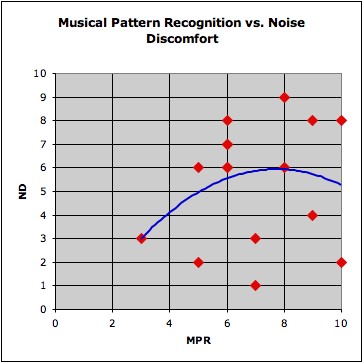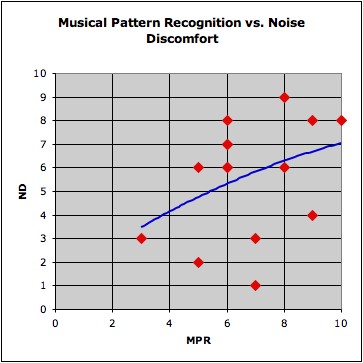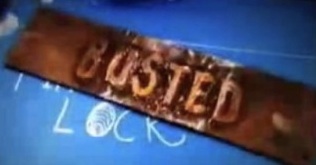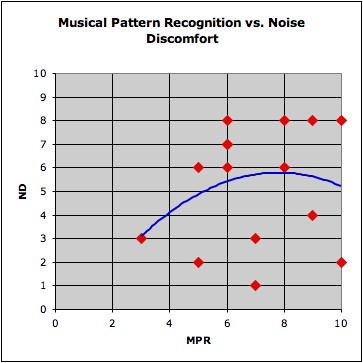Reaffirm my lack of skill at Scrabble.Take long nap on couch in sunbeam. Endure withering stares from cat, whose spot and habit I usurped.Watch a truly staggering amount of invertebrate sex.Attend child’s birthday party with bouncy castle. Bounce. Rip pants.For second year running, win “lamest halloween costume” award, this time with sketch of ghost magic markered on top of bald head.Forget to remove costume before church.
Author Archives: SeanMcTex
Sound and Fury Redux
First off, a great big “Thank You!” to the 16 people who chipped in with data for the little experiment I proposed in Chaos and Form, Noise and Music: A Mini-Research Project! It was great fun to see all of your experiences and discussion rolling in, and to root for the data to go one way or the other. I really appreciate your participation!
Here is a graph of all the data I eventually received:

Based on this plot, I’m guessing that my theory doesn’t hold water. If it were true that a low tolerance for noise were the result of the pattern recognizing parts of your brain going into an overactive frenzy, I would have expected to see the trend to start low in the bottom left corner of the graph and to steadily rise toward the right side of the graph — obviously not what actually happens in reality.
But wait! This may just be a product of the small sample set. Look what happens if I remove a single outlying data point (Barry Brake, I’m looking at you):

Suddenly, the curve becomes almost exactly what I would have predicted. So, I’m left with two possibilities:
- My theory is dead wrong.
- I need more people to answer my little quiz to get valid results.
Any of you statisticians out there care to weigh in? My theory may have life in it yet, but until I get more data, I guess I’ll have to consider this theory:

Hovercraft Building
The inimitable Jason Young and I took this past Sunday to build a hardware store hovercraft out of wood, plastic sheeting, a leaf blower, and peanut butter. (Note: one of those things is a lie.) We then set my children (read: “lab rats”) floating down the street on it like passengers on a giant air hockey puck. We had a super time constructing and running the thing, and highly recommend it as a weekend project for anyone inclined toward similar sorts of potentially dangerous madness.
Please enjoy the video, won’t you? Thank you. [Note for Facebook friends: the video quality on Facebook is much better than that on Google Video.]
A 7 Year Old Magpie
Our own Margaret turns 7 years old today. Happy birthday, sweetheart!
Hard to believe that our youngest is now that far along in life. I guess this parenting adventure won’t last forever after all!
Look At The Size Of That Thing!
My friend Joshua Kriegshauser, with whom I worked at Electronic Arts, has posted a magnificent video of his assembly of the 5,200-piece Millennium Falcon lego kit over the span of 11 days. Be sure to watch for the outfit changes!
Tremendous work, Josh!
Chaos and Form, Noise and Music: A Mini-Research Project
NOTE: This is an audience participation post. See the bottom for how you can help!
The other afternoon, I was listening to WNYC’s Radio Lab, a show from a New York public radio station. Radio Lab always has really interesting shows, where they take a topic and run with it wherever the curiosity of the inquisitive hosts leads. The topic du jour was Musical Intelligence, and the major chapters of the program included tonal language as it relates to perfect pitch, our tendency to use baby talk as a surrogate and supplement for touch, and a music composition program that uses human composers’ scores as input.
(Interesting fact: people who grow up speaking tonal languages, such at Mandarin or Vietnamese where the pitch at which one speaks a work alters its meaning, have a 75% incidence of perfect pitch, whereas the rest of the world has 10% or less.)
One of the topics the show discussed was how the brain deals with unfamiliar sounds. Since our gray matter likes nothing better than recognizing and ordering patterns, there’s a dedicated group of neurons that spring into action whenever a new sound intrudes upon your ears. These neurons try to process and catalog the incoming noises. If they fail, they dump out some dopamine, a neurotransmitter that can affect one’s mood.
Now, I have a rather curious quirk: I hate being in noisy places. Being in a restaurant with lots of people and hard surfaces becomes almost physically uncomfortable for me after a mere 5 minutes or so. But playing in or listening to a loud band doesn’t bother me in the same way — my problem seems to be mostly with unstructured sound.
When I heard about this pattern-recognition center in the brain, it occurred to me that perhaps the reason for my aversion to noise is that my brain is unusually aggressive in its attempts to recognize patterns, and when it can’t do so, gets fatigued quickly. This theory would seem to be supported by the fact that I have good relative pitch, and can transcribe a melody I’ve heard more easily than most people. (This, by the way, is my sole gift as a musician, and is the reason I tend to like learning new instruments more than mastering old ones.)
So, to help me corroborate my theory, I need your help! I’d like to find out how people’s skill at recognizing musical patterns correlates to their level of discomfort with noise. If you could help by rating yourself on a scale of 1 to 10 in each of those areas, I’ll compile the results and see if there’s any statistically significant correlation between the two numbers.
To help out, here’s what the scales will be:
- Musical Pattern Recognition: 1 (tone deaf) – 5 (can usually hum back a melody after hearing it a couple of times) – 10 (can unerringly write down or play a melody after hearing it once)
- Noise Discomfort: 1 (fine working in a noisy factory) – 5 (happy at a cocktail party) – 10 (don’t like to go public places without earplugs)
So, for my own assessment, I’d give myself an MPR of 8 and a ND of 8 as well.
So, if you’re willing to help, leave a comment with your rating of yourself in these areas! I’d love to have ratings both from other people who are musical and who aren’t so that I can have data on both sides of the equation. Thanks in advance for your contributions, gentle readers!
UPDATE: Early results are coming in. There’s a definite clustering at one corner of the graph. Come on, non-musical and/or noise-loving people, we need to hear from you!
UPDATE 2: More data, and a trend line on the graph now. There is a bit of a trend emerging, though Barry skewed the far end, which may put the lie to my theory. We need some non-musical people to help fill in the gaps for us!
UPDATE 3: You guys rock. Thanks for all the good data. I’ve plotted the additional information, and the correlation I expected look less and less strong. It is interesting that there seems to be an inverse bell distribution on the noise tolerance taken by itself — people seem inclined to be either bothered not much or a fair bit by it. I’ll keep gathering data for a week to gather any stragglers and then post final results.
Loot!
While shopping for Maggie’s birthday, I stumbled across a copy of Loot, a pirate-themed card game I remembered having read good things about. Noticing the various award stickers plastered across its box, I decided it was worth dropping a few bucks to try it out.
After I spent a couple minutes scanning the rules, Liam, Abigail and I played through one round with our hands down on the table in front of us to help learn the game, and then another the proper way with our cards hidden. The play is fairly straightforward and easy to pick up — no trouble for our 8 year old, and I think our 6 year old could have kept up with a little coaching — but the strategy becomes moderately deep once you don’t know what resources your opponents have at your disposal.
Some other reviewers suggest putting in chocolate treasure coins and having everyone talk like pirates for the duration to enhance the fun, but we really enjoyed it even without the additional pirate trappings and in spite of (or because of) the fact that the kids walloped me both times. Good, approachable fun. I give it a 2.5 on a scale of -7 to π.
Weekend To-Do: Postmortem
Prove that I’m still constitutionally capable of eating nothing that isn’t fried for a 24 hour period. Regret it.Attend library book sale. Feel inordinately pleased with myself for finding several books and CDs, the existence of which I’d been previously unaware and without which my life would have been no less rich.Spend 92 minutes mulling the question: “Littlest Pet Shop or My Little Pony?”Give Liam a Mohawk. Make plans to tell Principal of school that it’s part of his religious observance.Create elaborate plans for putting an end to our plumbing problems in the front bathroom.- Actually implement elaborate plans for putting an end to our plumbing problems in the front bathroom.
Give a Laptop, Get a Laptop
I’ve been intrigued by the One Laptop per Child initiative for several months. Some of my interest is philanthropic, though part of me suspects that if we’re really interested in helping the youth of the planet, these funds might better go toward clean water, health care, and more traditional education. The bigger reason that it has caught my eye is technological: in order to meet their goal of creating a flexible, low-maintenance, hackable laptop that can be manufactured and sold for $100, the initiative is doing a lot of really interesting work on both the hardware and the software. If you’re interested in the details, this tech talk is a good starting point.
So, when I heard on NPR that they were going to have a Give One Get One promotion starting in November, my inner philanthropist held hands with my inner technologist and skipped together up to my brain and kicked the living cheese out of my inner spendthrift.
The deal? You plunk down $400. They send you one laptop, and send another to a child in some far-off place.
“Wait a minute!” I hear the more mathematically astute of you shout. “That’s $200 per laptop! What’s up with that?” Well, that’s the rub. There haven’t been enough governments placing orders for the computers to get the economies of scale up to the point where the costs drop to the $100 target. So, by allowing people in the US to place orders, they increase manufacturing volume, causing prices to drop as the expense for specialized components is spread over more units.
I’m really interested to see how this works out for them, as well as to get my hands on one of the little laptops and see what their capabilities are like. At the very least, I expect it to be decent for typing papers and doing Internet research — two vital tasks with 5 students in the house currently!
More to come in December when we get our hands on one of these things and put it through its paces.
Moving Servers
Dear Internet:
I am currently in the process of moving this weblog from one server to another. The old server was having troubles that my hosting service was unable to figure out how to fix, so I’m relocating to one of their shiny new boxes with Solaris on it. Things may be slightly bumpy while I work out any kinks, but I should be a more cheerful blogger once the dust settles, since I won’t have to deal with the scourge of comment spam any longer. Hooray!
Your friend,
Sean
UPDATE: A big thank you to Greg Pierce, who pointed me to the excellent Bad Behavior plugin to help keep the comment spam in check.

